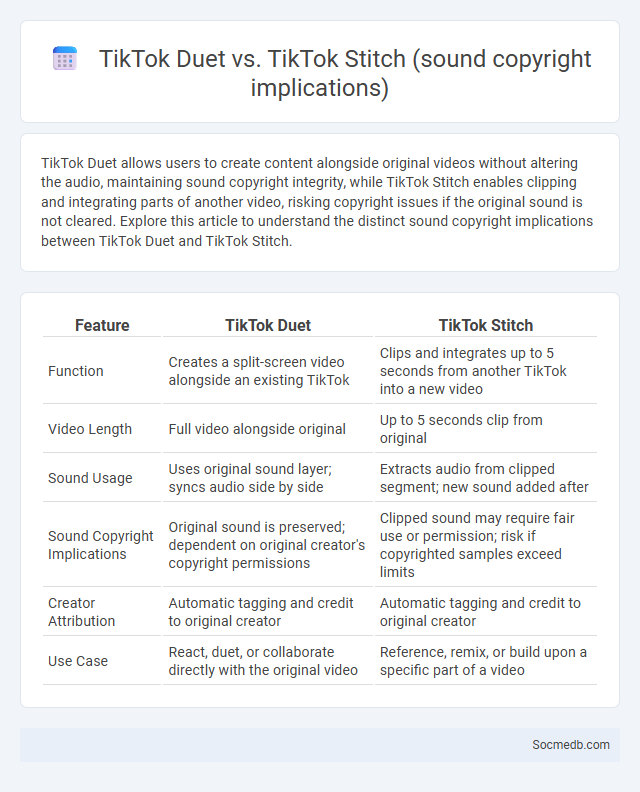
Photo illustration: TikTok Duet vs TikTok Stitch (sound copyright implications)
TikTok Duet allows users to create content alongside original videos without altering the audio, maintaining sound copyright integrity, while TikTok Stitch enables clipping and integrating parts of another video, risking copyright issues if the original sound is not cleared. Explore this article to understand the distinct sound copyright implications between TikTok Duet and TikTok Stitch.
Table of Comparison
| Feature | TikTok Duet | TikTok Stitch |
|---|---|---|
| Function | Creates a split-screen video alongside an existing TikTok | Clips and integrates up to 5 seconds from another TikTok into a new video |
| Video Length | Full video alongside original | Up to 5 seconds clip from original |
| Sound Usage | Uses original sound layer; syncs audio side by side | Extracts audio from clipped segment; new sound added after |
| Sound Copyright Implications | Original sound is preserved; dependent on original creator's copyright permissions | Clipped sound may require fair use or permission; risk if copyrighted samples exceed limits |
| Creator Attribution | Automatic tagging and credit to original creator | Automatic tagging and credit to original creator |
| Use Case | React, duet, or collaborate directly with the original video | Reference, remix, or build upon a specific part of a video |
Introduction to TikTok’s Creative Features
TikTok offers a dynamic platform for creativity with features like video effects, filters, and an extensive music library that empowers users to produce engaging content. You can leverage tools such as Duet, Stitch, and green screen to collaborate and innovate, enhancing your videos' appeal. These creative features make TikTok a unique social media app that drives viral trends and fosters interactive storytelling.
What Is TikTok Duet?
TikTok Duet is a popular feature that allows users to create split-screen videos alongside an existing TikTok video, enabling interactive and collaborative content creation. Your video plays simultaneously with the original, encouraging creativity, reactions, and engagement within the TikTok community. This tool is widely used to remix trends, respond to challenges, and build social connections on the platform.
What Is TikTok Stitch?
TikTok Stitch is a feature that allows you to clip and integrate scenes from another user's video into your own, facilitating creative responses and collaborations. This tool enhances engagement by enabling users to build on existing content, offering a new way to participate in trends and conversations. Using TikTok Stitch can expand your reach and foster community interaction by seamlessly blending original and shared content.
Comparing TikTok Duet and Stitch
TikTok Duet allows you to create side-by-side videos that play simultaneously, encouraging direct interaction and creative collaboration with another user's content. In contrast, TikTok Stitch enables you to clip and integrate up to five seconds of someone else's video into your own, providing a seamless way to respond, comment, or build upon existing content. Your choice between Duet and Stitch depends on whether you want to interact in real-time alongside the original video or incorporate a specific segment into your narrative effectively.
TikTok Duet: Sound Copyright Considerations
TikTok Duet functionality requires careful attention to sound copyright as unauthorized use of protected audio can lead to video removal or account penalties. Users should ensure the audio clip is either original, licensed, or falls under TikTok's royalty-free sound options to avoid infringement issues. Understanding TikTok's copyright policies and leveraging licensed sound libraries can help creators safely engage with the platform's duet feature.
TikTok Stitch: Sound Copyright Challenges
TikTok Stitch offers users a creative way to engage with existing videos, but it raises significant sound copyright challenges due to the platform's vast library of user-generated content. Content creators must navigate the complex landscape of copyright laws to avoid infringement claims when using copyrighted audio clips in their Stitches. Protecting Your content while respecting sound copyright is crucial for maintaining compliance and fostering a safe sharing environment on TikTok.
How TikTok Handles Sound Copyright
TikTok employs advanced audio recognition technology and a robust licensing framework to manage sound copyright, ensuring that copyrighted music and audio clips are used legally on its platform. The company partners with major music labels and rights holders to secure global rights, enabling users to incorporate popular tracks while compensating artists appropriately. Content flagged for copyright infringement is either muted, removed, or restricted, maintaining compliance with international copyright laws.
Content Creator Risks and Liabilities
Content creators on social media face significant risks including intellectual property infringement, defamation claims, and breaches of platform policies that can lead to account suspension or legal action. Misleading or false information shared can result in reputational damage and potential lawsuits, particularly under regulations like the Digital Millennium Copyright Act and the Communications Decency Act. Creators must ensure compliance with advertising standards, privacy laws, and copyright regulations to mitigate liabilities and protect both their brand and audience trust.
Legal Best Practices for Using Sounds on TikTok
Using sounds on TikTok requires strict adherence to copyright laws and TikTok's licensing agreements to avoid legal issues. Users should only upload or share sounds they have the rights to or that are provided within TikTok's licensed library to ensure compliance. Maintaining clear records of sound sources and permissions can prevent copyright infringement claims and protect account integrity.
The Future of Sound Copyright on TikTok
The future of sound copyright on TikTok hinges on evolving digital rights management and AI-based content recognition technologies that aim to protect creators' original audio. Platforms like TikTok are increasingly adopting blockchain and smart contracts to ensure transparent licensing and fair revenue distribution for sound owners. You must stay informed about these advancements to safeguard your creative assets and leverage opportunities in the rapidly changing sonic landscape.
 socmedb.com
socmedb.com